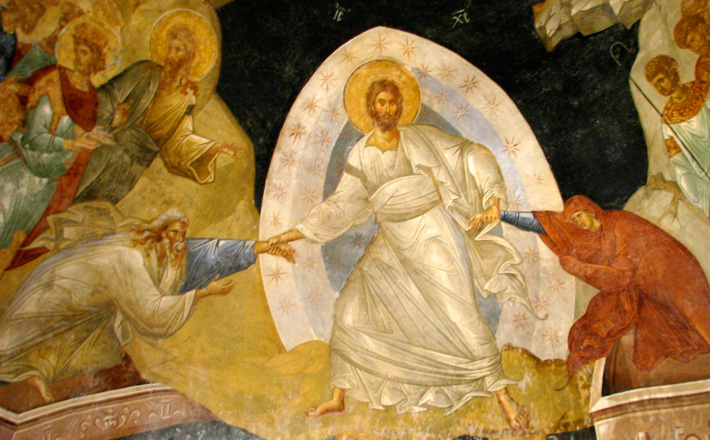Commentary on Haggai 1:15b-2:9
The small book of Haggai stands on par with other prophetic books in many respects.
While we know little about the person named Haggai, the book boasts the successful completion of work on the temple in the restoration period. After effectively encouraging the dispirited, apathetic, and indifferent community to begin work on the dilapidated temple (Haggai 1:12), Haggai needs to offer further inspiration in response to the inevitable lag in enthusiasm once the enormity of the project is realized. This lection forms the heart of Haggai “pep talk” to all members of the community. However, Haggai as prophet is more than a mere cheerleader: it is a theological voice that helps the community understand the meaning of its major symbol.
The odd verse division that starts this passage serves as a helpful marker in its interpretation. The reader should immediately recognize the ambiguity of the date, the second year of Darius, in relation to the two surrounding events. Standing in the middle of the previous event, the commencement of the work on the temple (Haggai 1:14), and the new event, the oracle offering encouragement to continue, the date formula looks backwards and forwards. These two critical events hang together in the same year, just as the formulaic writing of the book binds them together as deeply contemporary events. Readers need to hear Haggai speaking in real time as opposed to either a generic time or abstract eschatological moment. Capturing Haggai in real time helps to sense how he responds to the felt needs of the community and moves them forward in their work.
The details of the community given in Haggai suggest either an asset the community already possesses or needs to possess. Shared leadership, collaboration between civic and religious leadership, inclusion in religious decisions, and overcoming of internal differences are aspects vital to the integration and self-identity of the community. Haggai pushes the need for the community to work together even further through the conversational question and answer style of the oracles. This pattern mirrors the communication between Haggai and God. The supplication formula present in the Hebrew of Haggai 2:2 seems out of place in prophetic literature where prophets as messengers are told what to say. Instead, God requests Haggai to speak, inviting him into an interaction.
So, too, Haggai initiates interaction with the people echoing their assessment of the state of the temple as the basis for encouraging their continued work (verse 3). Rather than simply hearing the words of Haggai, readers hear from the community thus foregrounding the critical role of the community. As Haggai offers encouragement, he singles out the leaders and the people using the same word in every instance. Unlike the often repeated “do not fear” of Isaiah (e.g., Isaiah 7:4; 35:4; 40:9 and Haggai 2:5), “take courage” (verse 4), echoing Haggai 1:13, reads here as Tim Meadowcroft sees it, as “be strong and effective.”1
Haggai rallies the community for the task of restoration of the temple precisely because the temple serves a critical function in the community. He adds the international impact of the temple to comments on the need for the temple given in chapter 1.Haggai sees God’s honor as the pressing argument for the restoration of the temple (1:4, 9) not merely because God needs a house to reflect such honor, but rather because the state of the building reflects the people and their relationship with God.
Haggai presses the point of divine honor further by opening up before the eyes of the community what the completed temple would mean for God’s role in the world. The completion of the temple will be marked by an earth-shaking event that shall signal to the nations of the world to come to the temple (verses 6-7).
Earthquakes and other natural occurrences appear in prophetic literature as signals of impending punishment (see Ezekiel 3:12; 38:19, Jeremiah 10:10, 22; 47:3); however, Haggai uses it to announce the inflow of global treasures into the temple. While the phrasing of verse 6 may sound eschatological, preachers should remember the strict dating system of the book in order to keep Haggai’s concerns within contemporary time. The plural form of “treasure” in Hebrew makes it unlikely as a referent to a single item or person, therefore ruling out a messianic association. The treasure of the nations appears as silver and gold in verse 8 and will contribute to the improved magnificence of the temple (Haggai 2:9).
Haggai’s words do more than offer a “build it and they will come” encouragement as seen in the movie Field of Dreams. Even more, Haggai is not offering the forced correlation popularized by the “prosperity gospel” between dedication to God and the guarantee of success. Instead, Haggai calls the people to acknowledge the centrality of the temple given their past and their future.
In recalling the past, Haggai reminds them of the security of the promises of God as seen in the exodus (the Hebrew verb used here is normally used in covenant making verse 5). Haggai’s preferred expression, “the Lord of hosts” (the archaic term “hosts” is better read as “armies”), reflects the confidence of the temple as the site of a powerful militaristic God. The book accounts for five percent of the uses of the term “Lord of hosts,” even though it comprises only two tenths of one percent of the Bible. When paired with Zechariah and Malachi, these three books are responsible for one-third of the occurrences of this expression in the Bible.2This concentrated use of “Lord of hosts” by books dealing with the restoration period and, in particular the temple, suggests a recall of the days when the temple was established during the Davidic monarchy. Its restoration reflects the honor of the people in past and current generations for God.
The future Haggai consists of the restored temple and God’s promise of prosperity (verse 9). This verse lays out a correlation between the temple and full flourishing (NRSV, “prosperity,” KJV “peace) that can too easily be interpreted as a causal relationship. The NRSV renders the Hebrew shalom as “prosperity.” And while a technically correct translation, this remains insufficient. In any event, preachers should avoid reading Haggai as motivating the restoration of the temple in order to receive wealth. The motivation that Haggai lays out consistently points to God’s activities. God performs the earth-shaking function (verse 6) that results in the arrival of the nations’ treasures (verse 7a). God fills the temple with glory and God provides prosperity (verse 7b).
The process of the restoration of the temple in Haggai resembles elements of the temple’s construction under Solomon — resources from other nations, finest construction material (1Kings 7:13-51). If Solomon takes the credit for a building of glory, the honor of its restoration belongs to God. Therefore, since in this passage God appears as the builder, the restored temple will surpass its previous state in magnificence.
The community, though, still needs to do its part in restoring the temple. The work of the people serves as an expression of God’s work among them. The people honor God through the temple precisely because they have experienced God’s promises in history in events like the exodus and the restoration to the land. Undoubtedly, benefits will be derived from a restored temple and Haggai appears to admit this. However, the motivation for the restoration of the temple remains God’s honor. Not satisfied with an incomplete project or half-hearted measures, Haggai pushes the community to offer its best to God.
1 Tim Meadowcroft, Haggai (Readings: A New Biblical Commentary; Sheffield Phoenix, 2006), 157.
2 Ibid., 103.


November 10, 2013